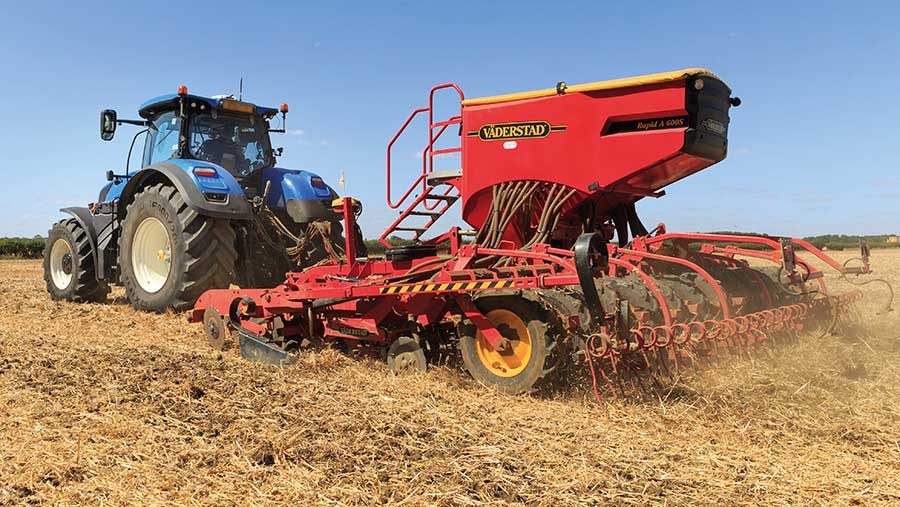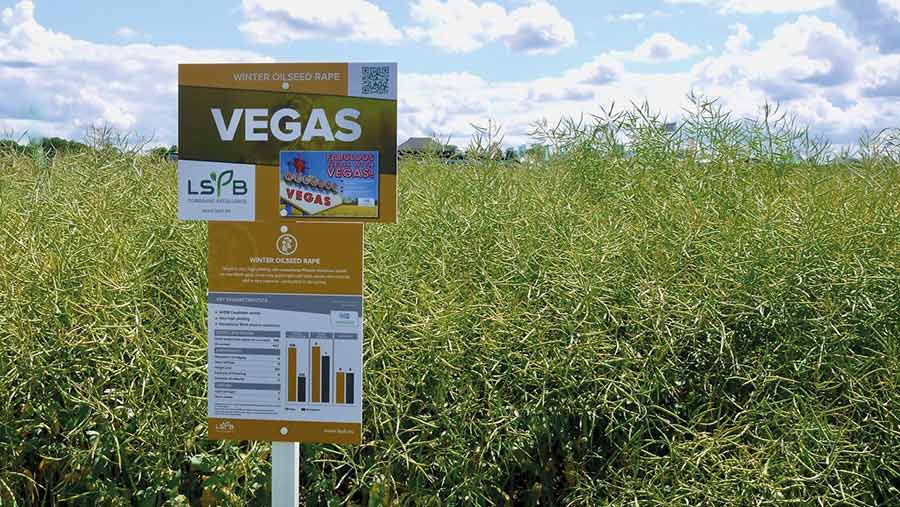What the new OSR varieties bring to the market
 © Tim Scrivener
© Tim Scrivener Seven new winter oilseed rape varieties joined the 2023-24 AHDB Recommended List at the end of last year, adding to the choice in all areas of the country.
They complete a line-up containing plenty of proven hybrids, with existing UK-wide choices Ambassador and Aurelia expected to sell well again, and East/West region options Dart, Respect and Flemming also tipped to be popular.
See also: How new tech aims to improve soil carbon measurement
Others that will be of interest include those on the useful “considered but not recommended” list produced by the AHDB – many of which are good performers packed with genetic traits and may now be discounted.
UK recommendation
Of the four newcomers with a UK-wide recommendation, just one is a conventional variety, says Colin Peters, Niab’s break crop specialist, with the remainder all hybrids.
The new conventional type, Tom, is a solid variety that sits mid-table for gross output on 102%.
While it doesn’t have the pod shatter and turnip yellows virus (TuYV) genetic resistance found in others, it has a very stiff stem, good resistance to lodging and a 7 rating for light leaf spot.
“Tom is a conventional variety with performance very similar to that of Acacia,” points out Mr Peters.
“It adds to the choice where conventionals are preferred.”
It is being marketed by Frontier Agriculture.
Otherwise, the UK-wide list is headed by two of the new hybrid additions, Turing from LSPB and Attica from Limagrain, both of which have a gross output of 107%.

Vegas OSR © LSPB
Turing sits at the top of the table and has a light leaf spot rating of 7, but doesn’t have the pod shatter and TuYV traits that are now found quite widely in others.
“It is less good on stem canker, with a 5, as the major R-gene resistance RlmS that most other LSPB varieties have in conjunction with quantitative resistance isn’t found in Turing,” he explains.
Attica is another strong variety from Limagrain and it is difficult to fault, says Mr Peters.
It offers good agronomic features and strong disease resistance, along with the genetic traits of pod shatter and TuYV resistance that the breeder is known for.
“It’s another Ambassador or Aurelia,” he says. “It has done well in trials and is bound to be of interest.”
The other hybrid newcomer, Vegas, also from LSPB, has something different to offer in terms of disease resistance, says Mr Peters.
“It has a good gross output of 105% and brings exceptional stem canker resistance with a 9 rating, along with an 8 for light leaf spot.
“That phoma score comes from the major R-gene resistance RlmS, which is only found in LSPB varieties at the moment. Expanding the genetic base for phoma resistance will help to reduce the current reliance on Rlm7.”
Vegas doesn’t have the pod shatter or TuYV traits, he says. “Despite all the hype about genetic traits, the lack of them doesn’t seem to have affected its performance in trials, which is often the case.”
East/West region
Murray, another new LSPB hybrid variety, is the only addition to the list for the East/West region, heading the table with a gross output of 106%.
It also has the RlmS major gene resistance, giving it an 8 rating for stem canker, which is complemented by a 7 for light leaf spot.
“Again, it doesn’t have the other genetic traits, but it looks to be a good addition to the list and takes gross output to the next level,” says Mr Peters.
North region
Wagner now sits at the top of the North region list, with an impressive gross output of 108% – putting it 6 points ahead of conventional Amarone.
“It’s a really good, solid hybrid variety with the full range of genetic resistance,” says Mr Peters. “The only exception to that is stem canker, which it has moderate resistance to.”
The other newcomer is herbicide-tolerant type Beatrix CL, which has a gross output of 94% in the North and 97% in the East/West region.
“It’s a sound variety with both the pod shatter and TuYV resistance traits. It also has a good stem canker rating of 7 and moderate light leaf spot resistance with a 6.”
Candidates
Just four of the nine winter oilseed rape candidate varieties have achieved national listing to date, reports Mr Peters.
Of these, two are up for recommendation for the UK, while the other two are for the East/West region.
Pi Pinnacle from Grainseed and Miraculux CL from DSV are being assessed for UK suitability, while Kanzzas from RAGT and Dolphin are potentials for the East/West region.
“They’ve still got another year to show us what they can do, but current information suggests they aren’t going to be exceptional. Time will tell.”
Attica’s appeal
Having sold almost 3,000ha of Attica last year, when seed was made available, United Oilseeds expects that growers will move forward with the new UK-wide variety in 2023 following its recommendation.
The company’s seed sales manager Beckki Gibbs believes it will find a place alongside Aurelia, which is another very strong hybrid variety from the Limagrain stable.
“For growers looking to change, Attica is the next best thing,” she summarises. “It offers a bit more yield and is packed with the genetic traits that the breeder is known for. It also carries the stem health label that has been introduced recently.”
It’s difficult to find reasons not to grow it, she notes. “Where oilseed rape has cemented its place in the rotation, Attica is a good choice from a list containing plenty of impressive varieties.”
Newcomer varieties |
|||
Variety |
Yield (gross output) |
Light leaf spot* |
Phoma* |
UK |
|||
| Turing | 107% | 7 | 5 |
| Attica | 107% | 7 | 7 |
| Vegas | 105% | 8 | 9 |
| Tom | 102% | 7 | 6 |
East/West only |
|||
| Murray | 106% | 7 | 8 |
North only |
|||
| Wagner | 108% | 7 | 6 |
| Beatrix CL | [94%] | 6 | 7 |
| []=limited data, *On a scale of 1-9, where nine is most resistant | |||

